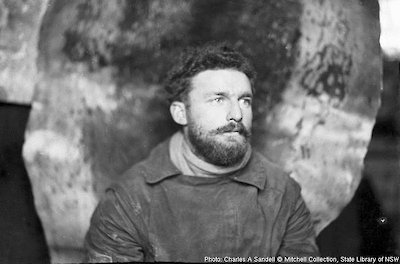Leslie Russell Blake
AAE position: Cartographer, geologist
Blake was born in Melbourne in 1890, but lived much of his early life in Queensland. He was working for the Queensland government’s geological survey department when Mawson selected him to join the Macquarie Island Party as geologist and cartographer –roles he filled with consummate skill and dedication.
Blake’s main tasks were to map the island and describe its geology. The latter task involved putting together a large collection of rock specimens — one of the foundations for later research into the island’s unique geology leading to its nomination as a World Heritage property.
But Blake’s surveying and mapping of the island was his major achievement. With just three years’ prior experience in field surveying, he completed a topographic survey of the island’s rugged 170 square kilometres by land and sea (in a tiny dinghy), with the help of the party’s biologist, Harold Hamilton.
Starting with a survey baseline on the northern plateau on 17 January 1912, Blake set up sighting poles on all prominent features to allow a topographic triangulation of the entire island. The end result was a detailed map of the island with contours at 200-foot intervals. (For the northern half the intervals were 50 feet.) The maps, published later in Mawson’s AAE Reports, were still being used in the 1970s.
After a short visit to the Antarctic mainland on Aurora’s final cruise, Blake returned to the goldfields of Queensland as a geologist, continuing his work on the Macquarie data and maps. But the outbreak of war in Europe saw him volunteering for the army. Initially he was turned down on medical grounds, but after hospital treatment he was allowed to enlist as a gunner. After brief service in the Middle East, he arrived in France as a second lieutenant early in 1916.
Late in 1916 Blake was awarded the Military Cross, for conspicuous and continual gallantry in the field during the Battle of the Somme, when under heavy fire he made a detailed survey of the Allies’ front line to help keep soldiers safe from ‘friendly fire’ during artillery barrages. Blake sent his medal back to his fiancée in Australia.
In July 1917, while taking part in the third Battle of Ypres, Blake was photographed by his old friend from the AAE, Frank Hurley, now an official war photographer. In September 1917 he was wounded in the arm by shrapnel and evacuated to England. After rejoining the fighting in February 1918, he was promoted to captain in May.
In the war’s final offensive that broke the German Hindenburg Line late in 1918, Blake was on horseback on 2 October when he was hit by a shell which killed his horse and wounded him badly, blowing off his left leg. He died early the following day and was buried in the military cemetery at Tincourt.

